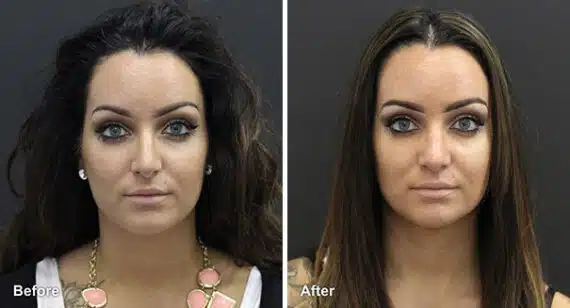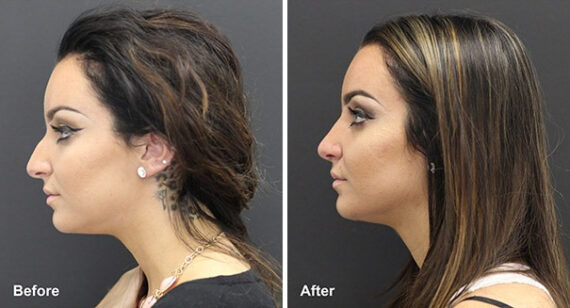Double Board certified in facial plastic surgery and otolaryngology (head and neck surgery), Dr. Nicole Schrader has specialized experience performing rhinoplasty in men and women.
Rhinoplasty, also known as a “nose job”, transforms a misshapen nose and balances the size and appearance to complement and blend with the other facial features. Slight surgical alterations to the nose can provide dramatic improvement by harmonizing the facial features and profile.
Rhinoplasty Procedure
Men and women who are considering nose job surgery in Princeton, New Jersey, visit rhinoplasty surgeon Dr. Schrader for a variety of reasons. The rhinoplasty results may be subtle or more noticeable, depending on the type of correction that is requested. Rhinoplasty can create many changes in the nose, including the following:
- Defining of the nasal tip
- Reshaping or reducing the nose
- Removing a hump
- Narrowing the width of the nostrils
- Changing the angle between the nose and the mouth
- Correcting an injury, congenital disability, or other problems that affect breathing
Dr. Nicole Schrader uses different techniques during open surgery, in contrast to closed rhinoplasty. She can augment the nose, smooth surface deformities, and enhance the profile to achieve aesthetically pleasing results. She uses conservative measures and tailors each technique to match the requests of the patient. Tailoring the rhinoplasty surgical plan is necessary to complement the individual’s natural beauty without creating a distraction.

What to Expect During the Procedure
Dr. Schrader performs rhinoplasty as an outpatient procedure using general. She begins by making incisions to access the underlying bones and cartilage that support the nose. The incisions are usually made inside the nose where they cannot be seen after surgery. Depending on the desired result, some bone and cartilage may be removed. Sometimes tissue may be added, either from the deviated septum or ear cartilage. After Dr. Schrader has rearranged and reshaped the bone and cartilage, she redrapes the skin and tissue over the new structure of the nose. A splint is placed on the outside of the nose to support the new shape as it heals.
Rhinoplasty Surgical Recovery
Recovery after rhinoplasty depends on the details and extent of the procedure. Post-surgery swelling and bruising on the nose and around the eyes are common and should be expected, but these symptoms will gradually improve over the first two weeks. Most patients feel uncomfortable and achy with a light headache for the first few days. Dr. Schrader usually removes the sutures and splint seven days after the surgery. Patients typically return to work in one week, depending on the activity level and the type of job. Light activity can be resumed one week after the surgery, but patients must avoid strenuous activities for approximately 2 weeks. The results will be evident in two to three weeks as the nose job swelling subsides.
Rhinoplasty before & after photos
* All patients are unique and individual results may vary.
Rhinoplasty Expectations
Dr. Schrader tailors the rhinoplasty treatment to complement the individual’s natural beauty without creating a distraction. Rhinoplasty is used to alter or improve an oversized nose, saddle nose, hump and other nasal structure conditions. Dr. Schrader explains in detail the rhinoplasty treatment goals and expectations during the consultation.
Rhinoplasty Consultation
Dr. Schrader meets with each patient in a private patient-doctor consultation to discuss the rhinoplasty surgery. This is the perfect time for the patient to share their goals and expectations. During the meeting, Dr. Schrader reviews the patient’s health history, examines the patient’s nose, and shares before and after photos of previous patients. Dr. Schrader completes the consultation with a professional recommendation and answers each of the patient’s questions and addresses any specific concerns that they may have. She will also explain the different rhinoplasty benefits.
The Ideal Rhinoplasty Candidate
The ideal rhinoplasty candidate is in good health, doesn’t smoke and has realistic expectations. Male and females who want to reduce the size of their nose, improve the appearance of the nose, or resolve breathing problems caused by nasal structure problems may be considered ideal candidates for rhinoplasty. Rhinoplasty should only be performed on a fully developed nose. Female patients usually reach complete facial development by age 15 or 16 and male patients by age 17 or 18. If cosmetic surgery is performed before this time, the continued development of the nose can alter the surgical results and may create complications.
Rhinoplasty Cost
A variety of factors affect the cost of nose surgery, including the complexity of the aesthetic enhancement and if breathing problems are also being addressed. Dr. Schrader strives to keep her rates competitive with other New Jersey plastic surgeons without sacrificing patient safety or results. When it comes to the delicate surgery of the nose, it’s important to avoid revision procedures if at all possible; therefore, consider the quality of your surgeon and the care you will receive above cost.
Common Rhinoplasty Questions
Schedule Your Consultation in Princeton, NJ
If you are dissatisfied with your nose or having breathing issues and would like to learn more about rhinoplasty, call 609-279-0009 to schedule a consultation with Dr. Nicole Schrader in Princeton, NJ, or contact Schrader Facial Plastic Surgery. We have three convenient locations in Princeton, Robbinsville and Voorhees, NJ. We look forward to meeting you!
Why Choose Dr. Schrader
- She is a double board certified surgeon in Facial Plastic and Reconstructive Surgery and Otolaryngology & Head/Neck Surgery.
- Dr. Schrader is a member of the American Academy of Facial Plastic and Reconstructive Surgery
- She has over 20 years of experience, 15+ years in private practice and has performed hundreds of facelift surgeries.
- Dr. Schrader Recognized as Best Plastic Surgeon by Town Topics Readers’ Choice Awards.



